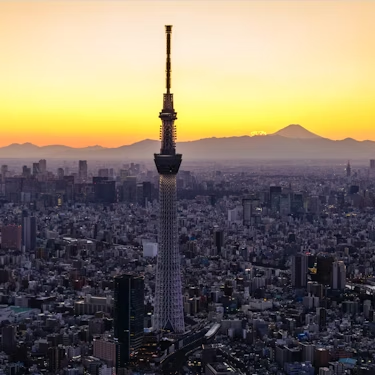More about: 10 Things to Do in Tokyo in February
February is a month when you'll find plenty of things to see and do in Tokyo, despite the cold weather. If you want to get to know the culture of the Land of the Rising Sun, during this month you will be able to see various traditions celebrated in Tokyo. Each has its own special symbolism and rituals that you can take part in.
Although Tokyo is a modern city, you can always find a way to connect with its ancient customs. You'll also see the unique way they celebrate world-famous dates such as Valentine's Day. What are you waiting for to visit Tokyo?
1. Celebrate Setsubun: the end of Lunar Winter
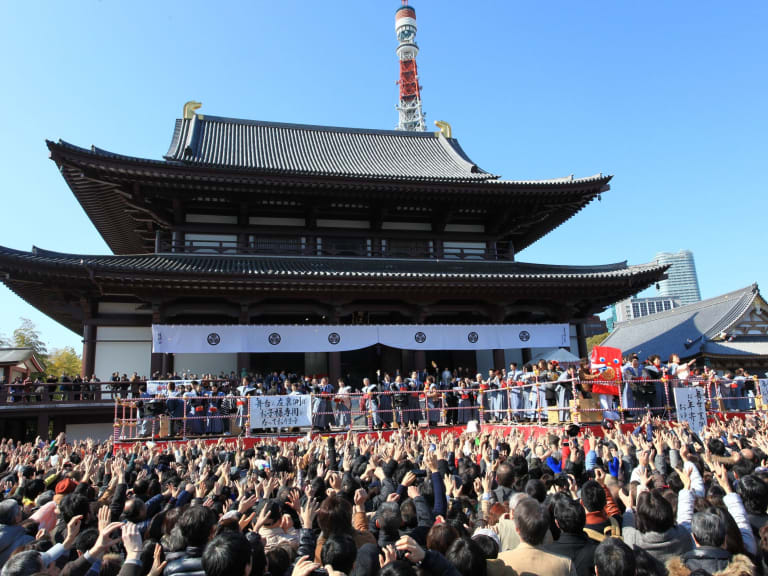
Year after year, Japan celebrates Setsubun or the end of the lunar winter at the beginning of February. Through festivals and rituals to bring good luck, the Japanese prepare for a new year and a new season. Although many traditions are done at home with the family, others take place in some temples in Tokyo that you can attend.
I recommend you visit the Senso-Ji Temple in Asakusa, in the Taitō district of Tokyo. During the celebration, roasted soybeans are thrown while the participants shout "oni wa soto! fuku wa uchi! which in English means: out with the demons, in with fortune!
To participate in this tradition, you can buy your bag of roasted soybeans at a supermarket, where you will also find the mask of oni, a demon in charge of punishing the wicked and unjust. After the seed-throwing, at Senso-ji Temple, the Dance of the Seven Lucky Gods of Japan is performed. It is said that watching this performance can bring good luck.
Another tradition of this celebration is to eat maki sushi in one bite and facing a fixed direction. This is a ritual so that good luck will not be broken. The direction to face varies from year to year according to the sign of the Chinese New Year. As a curious fact, this tradition was imported from China and became popular in Japan. Do you dare to scare away the demons and receive the fortune that spring brings with this tradition?
Practical information
- Location: Senso-Ji Temple in Asakusa, a district of Taitō in Tokyo.
- When to go: Can be held on 2 or 3 February, the date varies depending on when the lunar winter ends.
- Price: Admission to the temple is free.
- Time: The celebration at the temple starts at around 16:00.
2. See the plum blossoms blooming in February

If you love nature and flowers, February is the perfect month for you to visit Tokyo. In the middle or end of this month, the well-known plum blossoms or Ume, as they are called in Japanese, come into bloom and are the first sign that spring has arrived. Be prepared to go out to specific places in the city and take the best pictures. You can even take a photo tour of Tokyo to capture the most beautiful colours this flower has to offer.
The plum blossom is a symbol of perseverance, hope, purity and beauty, but also a reminder of how fleeting life can be. To see them up close and meditate on their meaning, I recommend going to Shiba Park in Tokyo's Minato district. From there, in addition to admiring the flowers, you will be able to see the famous Tokyo Tower. I also recommend visiting the Yushima Tenjin Shrine on weekends. On those days you can watch traditional Japanese music performances while the site is adorned with plum blossoms.
If you are looking for something more lively I invite you to attend the Setagaya Plum Blossom Festival. This festival is held in Hanegi Park in Tokyo. During the celebration you can taste plum-flavoured sweets, enjoy live music and free matcha tea. To participate in the festival you don't need to buy a ticket. Choose one of the ways you prefer to appreciate February flowers and have fun in Tokyo.
Practical information
- Location: Shiba Park is located in Tokyo's Minato Ward; Yushima Tenjin Shrine is located in Tokyo's Bunkyō Ward; and Hanegi Park is in Setagaya City, Tokyo.
- When to go: In mid- to late February, you can see the blossoms in different parts of Tokyo. Meanwhile, the Setagaya Plum Blossom Festival is held throughout February until mid-March.
- Price: Admission to the temple is free.
- Time: It is best to go out during the day to see the blossoms so that you can take as many pictures as you like.
3. See geisha in Tokyo's neighbourhoods during Setsubun

During the nights of Setsubun, a commemoration usually held around 3 February for the change of season, the geisha world holds the Obake. This is a carnival-like celebration where geisha dress up and attend gatherings and banquets. Although these celebrations are private events, you can find a way to see them up close, because they have become a cultural tradition throughout Japan.
Traditionally the geisha prepare their outfits throughout the year. When the special night arrives, they have a party where they can show off their costumes. These can be related to flowers or popular Japanese characters. It is common for them to be at Yasaka Shrine in Kyoto, near Tokyo, during the Setsubun celebration. So if you go around this time you will see them in their costumes ready for their private celebration and many will be happy to have their picture taken after all the effort it took to make their attire.
In case you can't travel to see them, I recommend going to the Tokyo neighbourhoods of Mukojima, Shinbashi or Asakusa. You will find geisha working in restaurants or temples whose dresses are the main attraction for tourists. Many of them will also be wearing them for Setsubun.
4. Celebrate the Itabashi No Ta Asobi festival

Itabashi No Ta Asobi is a festival held every year at Tokumaro Kitano Shrine and Akatsuka Suwa Shrine on February 11 and 13 respectively. Both shrines are located in Tokyo's Itabashi Ward. It is forbidden to drive to the event, so it is best to take public transport and walk to the shrine. Don't worry, after getting off the bus it's only a 5-minute walk.
During the festival, various rituals are performed to attract prosperity in the harvest and to bid farewell to the previous year. Nowadays the purpose of the festival is to maintain the tradition of field work. One of these rituals is Ta Asobi which means "playing in the rice field".
This ritual simulates the sowing and harvesting of rice and is held during the night as it was traditionally a secret celebration. The event involves humorous characters expressing wishes for prosperity and a child representing the health of future generations.
After this ritual comes the "okagari" ceremony at the Akatsuka Suwa shrine. Here the attendees gather and burn all the ornaments used in the New Year. This symbolises the burning of the misfortunes of the previous year and prays for a new year full of blessings and joy.
If you go to these celebrations I recommend that you bring a good coat, as it is usually cold in Itabashi during February. These celebrations are things you can do at night in Tokyo, as they start from 6pm until 11pm.
Practical information
- Location: both Tokumaru Kitano Shrine and Akatsuka Suwa Shrine are located in the Itabashi district of Tokyo.
- When to go: On 11 February, the Ta Asobi ritual is held at Tokumaru Kitano Shrine. On 13 February, the "okagari" ceremony is held at Akatsuka Suwa Shrine.
- Price: Admission to both events is free.
- Hours: Both events start at around 6pm and end at approximately 11pm.
5. Go to Some no Komichi or Dye Festival
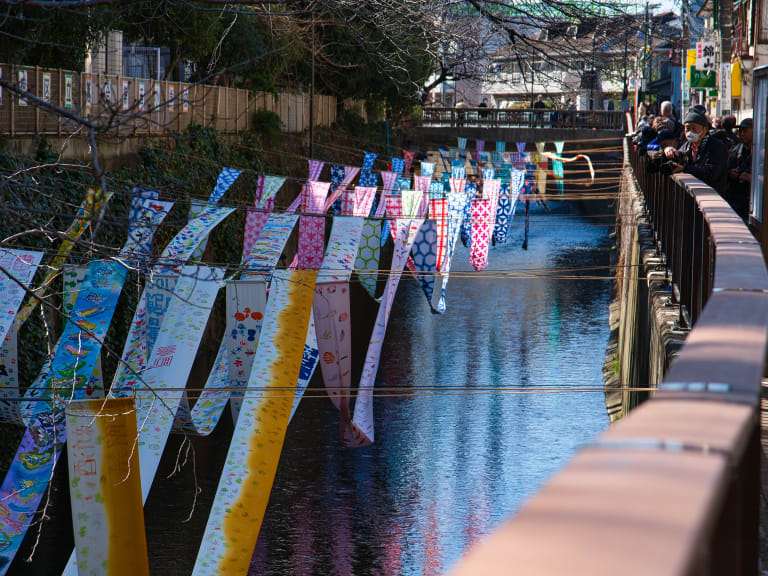
In the 1950s there were many dye factories along the Myōshōji River near Nakai Station in Shinjuku Ward, Tokyo. Workers cleaned fabrics in the river and it became a regular occurrence for the population. To remember this part of the city's history, the Some no Komichi has been held for 3 days at the end of February. If you travel to this area you will see long pieces of dyed cloth hanging over the river.
The cloth that is hung up is the "tan mono", usually boiled to fit the kimono so that the kimono can be passed on to other generations. In addition to photographing the river adorned with these fabrics, you can enjoy other activities. Usually the shops in the area offer kimono, dyeing workshops or display beautiful fabrics that you can also buy.
In these shops you will often see artists displaying their own decorated fabrics, so this may be your chance to acquire a unique work of art. It is important to note that a tradition of this celebration is to find a piece of cloth called a "noren" on the doors of the shops. This means that the shop is open to the public and you can come in.
Practical information
- Location: near Nakai Station in Shinjuku Ward, Tokyo.
- When to go: late February.
- Price: Admission is free.
- Opening hours: all day long you can see the fabrics hanging or visit the shops.
6. Participate in the Hari Kuo or Needle Funeral ritual

Hari Kuyo is a Buddhist and Shinto ritual that takes place on 8 February every year in the Kantō region of Honshū, the largest island in Japan, where Tokyo is located. The purpose of this custom is to thank the needles for the hard work of the past year. The ritual is mostly performed by housewives or people involved in sewing and fashion. You can visit the temples and be a spectator of this curious tradition.
In the main hall of the temple the monks perform a religious service as a symbol of the funeral of the needles. At this event 4 women dressed in Nara period clothing perform a dance. This dance is an offering in honour of Orihime, the divine weaver.
As an attendee of the funeral, you can take one of the needles and stick it into a block of konnyaku jelly. To do this you must say a prayer for the needles to rest. Temples that perform this ritual in Tokyo include Sensō-ji Temple or Tomioka Hachiman-gū Temple.
Practical information
- Location: Sensō-ji Temple is located in Asakusa, Taito City. Tomioka Hachiman-gū Temple is located in Tomioka, Koto City. Both are in the metropolis of Tokyo.
- When to go: 8 February.
- Price: Admission is free.
- Hours: You can attend the temple during the day.
7. Visit the kite market at the Oji Inari II Shrine

The kite market is a tradition held every year in February at Oji Inari II Shrine. The date may vary as it depends on Horse Day according to the Chinese zodiac, but it is usually in the first week of February. The kites have a special significance, as in the Edo period of Japanese history they were believed to protect against fires by cutting the wind.
It is now a custom to visit the shrine on this day. Outside the shrine there is a market where you can buy a kite for around €10. You can also find food and drink stalls here
Admission to the event is completely free, you only have to pay for what you consume or want to take away as a souvenir. You can attend from 10am until 6pm.
Practical information
- Location: Oji Inari II Shrine is located in Kishimachi, Kita City, Tokyo.
- When to go: Horse Day
- Price: Admission is free.
- Opening hours: You can attend the shrine from 10am to 6pm.
8. Dare to eat Mochitsuki

If you like to get to know new cultures through their gastronomy, you should take the opportunity to eat Mochi in February. It is a classic Japanese dessert that is eaten to celebrate the Lunar New Year, but in February it is the last opportunity of the year to eat it. If you want to try other typical foods I recommend you to take a food tour in Tokyo.
This sweet is prepared with rice that must be soaked and steamed. Then it has to be mixed in a mortar and pestle, where two people beat the dough with a piece of wood known as a kine. While they pound, another person mixes the dough with his or her hand. For many families it is a tradition to do it together, while laughing and taking turns. However, there are restaurants that prepare this sweet and have the fastest mochi cooks in the country, because there are even competitions for this.
If you want to try this particular sweet you can visit Takemura, one of the oldest restaurants that serve the classic mochi. This place is located in the city of Chiyoda.
9. Eat the best chocolates on Valentine's Day in Tokyo

If you travel to Tokyo during the 14th of February you can experience Valentine's Day in a different way. On this date women are the ones who give gifts not only to their romantic partners, but also to male relatives and friends. The gifts are usually typical Valentine's Day chocolates that come in different flavours and each one has a different meaning. Besides tasting these sweets, you will find romantic plans you can make on this day.
Among the chocolates you can eat or give as a gift is honmei-choko, which is the most special as it is given to the person for whom you have romantic feelings. Tomo-choko is for close friends, fami-choko is for family members and sewa-choko is for colleagues, classmates, bosses or teachers. Giri-choko is the cheapest chocolate and women give it to men with whom they do not have a close relationship.
These sweets can be bought in shops such as Gransta Marunouchi, located in Tokyo Station. A month later, on March 14, White Day is celebrated and it will be the turn of women to receive gifts. But chocolates are not the only thing you can have on your Valentine's Day while visiting Tokyo. Besides this gift exchange, you can have a romantic date in beautiful places in the city.
If you are travelling with your partner I recommend you to go to Odaiba, an artificial island located in Tokyo Bay. Here many couples come to have a romantic date which is usually for the purpose of confessing their love for each other. You can also go to Tokyo Tower, either to go up or to enjoy the restaurants and bars located around it. There is a tradition that says that when the lights go out at midnight if you are with your partner, you will be happier. How about eating chocolates at midnight in this tower?
10. Skiing in Tokyo's surroundings

February is still a cold month for Tokyo and if you like it, you can take advantage of this time to go to ski resorts around the city. This is definitely one of the things you can do in winter in Tokyo. In order to make it easy for you to travel for skiing, you should choose the closest places.
One of them is GALA Yuzawa Snow Resort. This is a resort that has a variety of slopes where beginners can learn. If you have intermediate experience I recommend Shiga Kogen Resort.
For any of the resorts you have to pay an entrance fee ranging from €40 to €20. Children pay the cheapest entrance fee, so this is an activity you can do with children in Tokyo.
Practical information
- Location: GALA Yuzawa Snow Resort is located in the Minamiuonuma district of Niigata. Shiga Kogen Resort is located in Shimotaki Ward, Nagano.
- When to go: The ski resorts are open from December to March, as long as there is enough snow.
- Price: Admission can vary from around €40 to €20.
- Hours: Typical skiing hours are during the day.
How busy is Tokyo in February and what are the prices like?
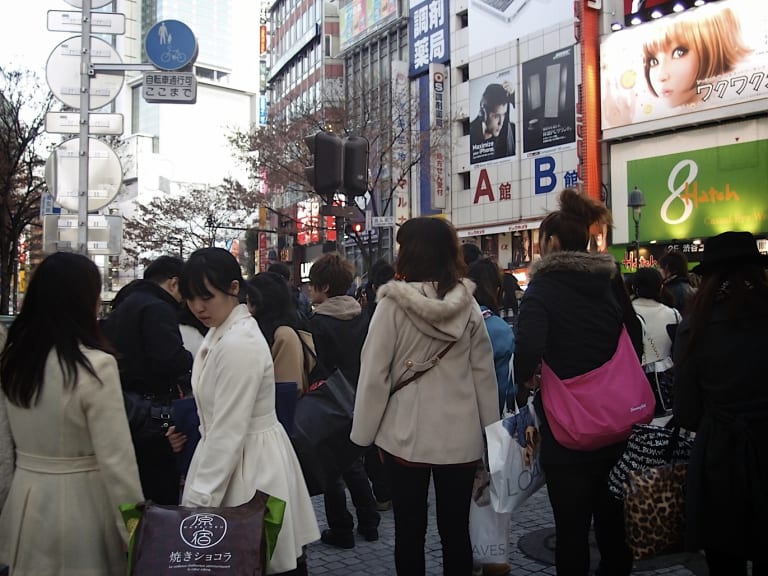
If you don't like crowds, February may be the best month for you to visit Tokyo. During this month it is still winter and there are not too many tourists visiting the city. This means you can explore more places without waiting in long queues, although it is always advisable to book in advance.
On the other hand, prices can be cheaper compared to other months. For example, a room in a 3-star hotel can cost an average of €100. For your reference, in July (the most expensive month) the same room can cost €170. But bear in mind that if you're spending a week in the city, you're sure to spend between €20 and €50 on transport and you'll also have expenses for food and entrance fees for different sites that you shouldn't miss out on. It's all a matter of calculation.
What is the weather like in February in Tokyo?

If you are thinking of travelling to Tokyo in February, you should know that it is just as cold as January. Like the previous month, there are only 6 hours of sunshine on average. Temperatures vary between 6 °C and 15 °C. However, the cold is a little more tolerable.
The breeze is a little light during this month and the humidity can reach 30%, but it is not very common. It is generally a dry month, with mostly clear skies. It also rains on average 5 days or more.
Traveller Tip
Tokyo is a city that is known for its extreme temperatures. In the summer months, it is too hot and in the winter months, it is too cold. Don't get complacent and try to plan your entire schedule around the temperature, especially if you're going to outdoor activities.
What to pack for a visit to Tokyo in February?
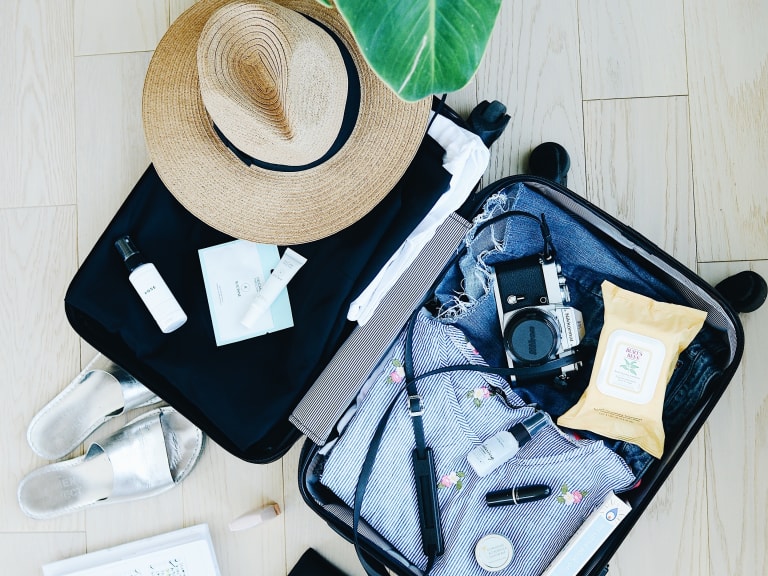
As it's a cold month, it's best to pack a coat that you can carry everywhere. Try to have comfortable clothes under your coat in case you are travelling to shrines or temples. Comfortable, warm shoes should also be packed in your suitcase.
Don't forget to bring your umbrella, as the rains start in February and you'd better have a way to protect yourself. Remember to make room in your suitcase to bring back home chocolates and other souvenirs of your time in Tokyo in February.



